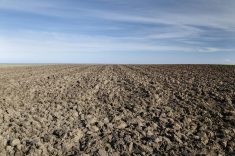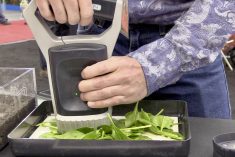The answer is ‘maybe’ — and probably ‘yes’ for sandy soils, but no research has yet been done in clay soils, according to University of Manitoba graduate student, Patrick Walther whose master’s thesis focused on soybean response to different tillage treatments.
Walther compared four tillage treatments in soybean crops — standard double disc, vertical till low- and high-disturbance systems, and strip tillage. In a strip-tillage system, producers till strips in the field and leave the rest of the field undisturbed. The three-year study consisted of on-farm trials at four Manitoba locations.
Read Also

Manitoba sclerotinia picture mixed for 2025
Variations in weather and crop development in this year’s Manitoba canola fields make blanket sclerotinia outlooks hard to pin down
The strip-tillage system consistently had lower nighttime and higher daytime temperatures than the other tillage regimes, which Walther speculates is because of the way strip tillage works. Strip-tillage equipment cuts residue with a cutting coulter, then pushes the residue aside with trash cleaners. A shank, discs and rolling basket follow and create a raised berm.
“Because the residue is set aside and not incorporated, it doesn’t act as an insulating layer, and the soil in the berm contains a lot of air which warms up and cools down faster than soil,” said Walther. “Soil radiation per square inch is also higher on the berm than on a flat surface.”
When it came to germination, the difference in soil temperatures didn’t make any difference in plant emergence, but at 47 days, the strip-tillage soybeans were already at 75 per cent flowering compared to the double-disc areas, which were at 25 to 40 per cent.
Although there was no significant difference in soybean yields between the four tillage systems, an economic analysis showed that strip tillage saves farmers money and time, largely because strip tillage requires only one pass, and the other tillage systems require two: one in fall and another in spring to prepare the seedbed.
Strip till versus no till
When it comes to comparing strip-till with no-till systems, long-term studies done in Illinois with corn and soybean rotations, have shown strip till significantly increased yields compared to a no-till system, regardless of whether fertilizer was broadcast or deep banded in each case.
These findings are significant because some producers assume that deep banding improves fertilizer efficiency and allows them to cut back on application rates, but that’s not what the research suggests, said Fabian Fernandez of the University of Minnesota. He discussed his research into fertilizer placement in strip-till and no-till systems.
“Strip tillage produced greater yields than no till, even with no phosphorus (P) applications, so there is no evidence to suggest that if a producer bands fertilizer he or she can reduce the amount needed; they still need to apply the same amount,” Fernandez told agronomists at the Manitoba Agronomists Conference in Winnipeg in December.
Fernandez emphasized that it was the tillage system which made the difference in yields in his studies, not the fertilizer placement. What is important to understand, said Fernandez, is where and how plant roots access moisture and nutrients. In a real farming situation, there are nutrients present in more parts of the soil than just where farmers apply fertilizer. Fernandez found the majority of plant roots developed in the top two inches of soil, regardless of whether fertilizer was deep banded at six inches or broadcast on the surface of the soil.
When the researchers measured drawdown of nutrients over time, plants reduced the amount of fertility in the top two inches of soil in both strip-till, deep-banded and no-till, surface-broadcast situations.
“When we applied P we saw a buildup in the no-till system where we applied at the surface, and in the banded application we saw a huge buildup of fertility at greater depth, but the plants continued to take quite a bit of nutrient out of the soil surface even though we hadn’t applied any fertilizer there,” said Fernandez. “Roots continue to take nutrient from where it is easiest to get, closer to the soil surface.”
Soil water content also affects the ability of plant roots to take up nutrients. “When we get a small rain event the surface layers of soil are recharged but the deeper layers aren’t,” said Fernandez. “In dryland agriculture, where we have intermittent rain events, the potential to recharge soil deeper down may be restricted. If producers apply all the nutrient in a deep band, when the plant takes up nutrient it also takes up water, and if that part of the soil dries up the chance of rewetting it is less likely.”
More roots doesn’t mean more yield
There was also greater organic matter content in the strip-tillage areas than the no till — 3.8 per cent compared to 3.5 per cent, which had an impact on the roots’ ability to penetrate the soil, and ultimately the yield.
“Within the first 10 inches from the seed row there was much lower soil penetration resistance in the strip till than the no till,” said Fernandez. “There were also substantial differences in root length densities. The no-till rows had about 17,000 miles per acre more root length than the strip-till rows.”
More roots are generally a good thing, but if the extra roots are there because the plants are sensing a stressful environment, that may not be so good.
“Plants put a lot of energy into their root systems and if they are growing in an environment where they sense some restriction, they will put more resources into developing the root system to compensate for a lack of water or nutrients,” said Fernandez. “That is why we saw substantially lower yields in the no-till than the strip-till system.”
The take-home message from a fertility standpoint is that the strip-till system outperformed the no-till system because it improved the OM content in the soil and that gave greater biomass and yield.
“There were much larger densities of roots, which the plant uses to take up nutrients, in the no-till system, but in terms of how much of that surface area was used to take up nutrients the strip till outperformed the no till quite a bit,” said Fernandez. “The smaller root system of the strip-till plants was able to use nutrients more efficiently than the no-till system, and it had nothing to do with how we applied the fertilizer.”
If asked where producers should apply fertilizer if they want to band it — for example in situations where they have high fixing soils for P or K, Fernandez suggested it might be more efficient to band it between the rows.
“Because the majority of nutrients is taken up at the surface and in the top two inches of soil, banding it between rows might be a good idea, but with strip tillage most people are not doing that. They tend to band the fertilizer in the tillage strip itself,” he said. “Having the correct level of fertility is more important than how you apply it — with the exception of high fixing soils. There is no evidence that producers can reduce rates by banding instead of broadcasting.”
Fernandez also reminded agronomists and producers that when they band fertilizer they need to make sure they take multiple soil samples from inside and outside the row to get a true picture of the fertility in the field.
A good sampling strategy is to take three cores outside of the fertilizer band for each core taken from the fertilizer band. “If they only sample where the fertilizer was banded, it will suggest they have more fertility than they have, and if they just take samples from between rows it might suggest fertility is lower than it is,” said Fernandez. “That could prompt them to apply fertilizer they don’t need and not get a return on it.”



















